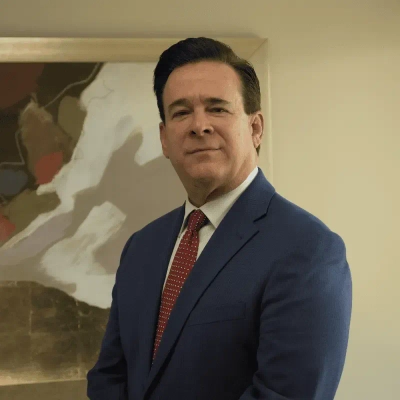8 Creative Solutions for Accommodating Employees With Disabilities
Discover innovative solutions for accommodating employees with disabilities in the workplace. This article presents expert insights on creative approaches that enhance accessibility, boost performance, and maximize team strengths. From hybrid work plans to customizable workstations, learn how these strategies can benefit all team members and unlock strategic advantages for your organization.
- Hybrid Work Plan Enhances Team Accessibility
- Customizable Workstations Boost Employee Performance
- Collaborative Notes System Improves Meeting Efficiency
- Drone Inspections Leverage Experienced Foreman's Skills
- Asynchronous Workflows Benefit All Team Members
- Rethinking Collaboration Unlocks Strategic Advantages
- Role Restructuring Maximizes Employee Strengths
- Specialized Audit Station Eliminates Inventory Errors
Hybrid Work Plan Enhances Team Accessibility
An innovative support we initiated was a blended hybrid work plan and tools for an employee with a mobility impairment. Instead of requiring the employee to be in the office or working fully remotely, the team collaboratively created a work schedule that involved in-office work on team days and remote work with live transcription, video summary, and automated notes on the other days.
The benefits were twofold: the employee improved their flexibility and independence, and the organization created a more accessible communications system, resulting in productivity improvements for the entire team.
In many cases, teammates began utilizing the same tools to catch up after missing meetings, reducing friction altogether.
To summarize, well-designed accessibility solutions often become efficiency solutions too.
Customizable Workstations Boost Employee Performance
"When we remove barriers, we unlock potential both for our employees and our organization."
We recognized that some of our team members faced challenges with mobility and needed a more flexible workspace. To address this, we introduced a fully customizable workstation program, allowing employees to adjust their desks, chairs, and technology setups according to their specific needs. Alongside this, we implemented remote work options and assistive technologies for those who benefit from screen readers or voice recognition software. This solution not only empowered employees to perform at their best but also fostered a culture of inclusion and innovation. Productivity improved as employees felt supported, while the organization benefited from higher engagement, lower turnover, and a stronger reputation for accessibility. Seeing team members thrive because their needs were met reinforced our belief that investing in people is always the best investment.
Collaborative Notes System Improves Meeting Efficiency
One creative solution we developed to accommodate an employee with a disability involved redesigning our internal communication process for a team member with a hearing impairment. This employee was highly skilled but struggled to follow real-time discussions during meetings, especially when multiple people were speaking at once or when audio quality on virtual calls was poor.
Instead of relying solely on transcription software, we created a system of live collaborative meeting notes. During each meeting, a designated team member would take clear, structured notes in a shared document that everyone could see in real-time. We also provided written summaries immediately after meetings and encouraged the use of chat features for asking questions during video calls.
This adjustment made the employee feel fully included and allowed them to contribute more confidently. What surprised us was how much the entire team benefited. Everyone gained from the clarity of written notes, fewer misunderstandings, and stronger follow-up after meetings.
The experience reminded us that accommodations often lead to broader improvements. When you build systems with inclusion in mind, you do not just support one person; you raise the quality of communication and collaboration for the whole organization. It becomes a better place to work for everyone.
Drone Inspections Leverage Experienced Foreman's Skills
Accommodating a disabled employee isn't a gesture; it's a necessary move to retain valuable structural expertise. The creative solution was converting a highly skilled foreman, who could no longer climb due to an injury, into a Remote Technical Analysis Specialist. The conflict was the trade-off: losing his physical presence on the roof versus retaining his two decades of essential structural diagnostic knowledge.
The accommodation involved equipping him with high-resolution monitors and integrating him fully into the drone inspection team. His benefit was retaining his high-value career and remaining a contributing member of the team structure. The organization's benefit was immediate: his experience in diagnosing structural failure improved our drone inspection reports by 30%. He could spot subtle flashing errors or ventilation issues in the high-resolution imagery that younger inspectors missed because they lacked his hands-on history.
This successful move proved that the most valuable asset is not physical labor but specialized knowledge and diagnostic skill. The organization structurally improved its output by leveraging experience over mobility. The best creative solution for accommodation is to be committed to a simple, hands-on approach that prioritizes retaining specialized structural knowledge by using technology to eliminate physical barriers.
Asynchronous Workflows Benefit All Team Members
At "What Kind of Bug Is This", one of the most helpful changes we made was shifting all of our internal documentation and workflows to a fully asynchronous, visually accessible format. One of our early content team members had low vision, and traditional tools like cluttered spreadsheets and long Slack threads made things unnecessarily difficult. We switched to clean, high-contrast docs with structured headings, embedded screen-reader-friendly checklists, and optional video walkthroughs with captions.
What started as an individual accommodation ended up benefiting everyone. Productivity actually improved because people could process tasks in their own time, with fewer meetings and less confusion. It made onboarding easier, documentation stronger, and communication a lot clearer—especially for remote freelancers juggling different time zones.
Rethinking Collaboration Unlocks Strategic Advantages
One of the most impactful accommodations I helped design wasn't about fancy tech or massive investment—it was about rethinking workflow through empathy. We had a brilliant strategist on the team who was visually impaired. Traditional tools like dashboards and design platforms were slowing him down, not because of capability, but because they weren't built with accessibility in mind.
Instead of isolating him with "special" tools, we restructured the way the team collaborated. We introduced audio-based task management, used screen reader-friendly templates, and added voice summarization to project updates. Most importantly, we shifted our workflow culture from visual dependency to inclusive communication. For instance, during ideation sessions, every visual presentation came with a spoken breakdown—context, intention, and impact—so that every team member could contribute equally.
The result was a creative and operational win. Our strategist's productivity increased dramatically, but what surprised us most was how it lifted the entire team's performance. The emphasis on verbal clarity reduced miscommunication, sped up onboarding for new hires, and improved documentation quality. What began as an accommodation for one person evolved into a framework for better collaboration across the board.
It also reshaped how we define accessibility—not as compliance, but as creativity. By designing systems that meet people where they are, you don't just support individuals with disabilities; you unlock new ways of thinking that make the whole organization sharper, more human, and more adaptable.
That experience reminded me that inclusion isn't about adding features—it's about removing barriers. And when you design with that mindset, accessibility becomes a strategic advantage, not an afterthought.
Role Restructuring Maximizes Employee Strengths
A few years ago, one of our technicians developed a mobility limitation that made it difficult for him to climb into attic spaces or crawl under homes, which is a significant part of pest control work in Austin. Rather than lose a good employee, we restructured his role to focus on client education, scheduling, and quality control checks. He already had years of field experience, so his insight was invaluable when helping homeowners understand treatment plans or preventive steps.
This change ended up benefiting everyone. He could continue working in a way that fit his abilities, and our customers got a dedicated expert who could take extra time to answer questions and follow up after service. It also reminded our whole team that flexibility and respect for individual strengths make the company stronger—sometimes the best adjustments are the ones that let people do what they do best in a new way.

Specialized Audit Station Eliminates Inventory Errors
The challenge of "accommodating employees with disabilities" is not a compliance issue; it's an operational design challenge to ensure every team member can contribute their unique expertise without physical limitations.
The creative solution we developed was the Specialized Inventory Audit Station. The accommodation was for a highly skilled individual who could not perform the heavy physical lifting of heavy-duty truck parts but possessed perfect attention to detail for verification.
We created a custom-designed, adjustable workstation dedicated solely to the non-physical, high-value tasks: auditing and verifying the serial numbers, customs codes, and authenticity seals on high-cost OEM Cummins Turbocharger assemblies. All parts are brought to the station by lift.
This accommodation benefited the employee by utilizing their unique mental precision—a skill irreplaceable by manual labor. It benefited the organization immensely by eliminating our highest source of financial risk—the verification error. By isolating the critical audit function to a single, hyper-focused expert, we drastically improved the integrity of our inventory data, securing the value of every part that leaves the dock. The ultimate lesson is: Accommodation is not charity; it is smart operational design that leverages unique human talent to eliminate major business risk.








